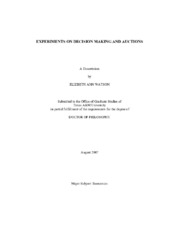| dc.contributor.advisor | Sarin, Rajiv | |
| dc.creator | Watson, Elizabeth Ann | |
| dc.date.accessioned | 2010-01-15T00:14:21Z | |
| dc.date.accessioned | 2010-01-16T02:21:41Z | |
| dc.date.available | 2010-01-15T00:14:21Z | |
| dc.date.available | 2010-01-16T02:21:41Z | |
| dc.date.created | 2007-08 | |
| dc.date.issued | 2009-06-02 | |
| dc.identifier.uri | https://hdl.handle.net/1969.1/ETD-TAMU-1918 | |
| dc.description.abstract | Experimental economics is often called upon to inform theory and aid in explaining real world behavior. As such it is important to carefully design laboratory experiments to test the validity of new theories and to reexamine results that demonstrate robust anomalies of classic theory. My first aim is to design an experiment that will allow me to test the propensity of subjects to use CaseBased Decision Theory (from now on referred to as CBDT). I carefully design a setting in which the predicted choices of CBDT are deterministic and unique to CBDT (i.e. different from the predicted choices of other relevant decision making processes). I examine how well CBDT organizes subject choices when subjects are asked to make thirty independent decisions each with a fixed and given history. I find that some subjects do appear to be using the information given to them in the form of CaseBased Decision making.
My second goal is to revisit traditional firstprice private values auction experiments with the idea of making the priceprobability tradeoff, the central consideration in auctions, more salient to subjects. I approach this in two different ways. First, I use a customdesigned graphical interface which displays all results both visually and numerically. In this treatment I find that subjects bid more aggressively than predicted by riskneutral BayesNash equilibrium. Second, I restructure the presentation of the idiosyncratic reservation value. Subjects are now engaging in some economic behavior and earning their total consumer surplus each period. This differs from traditional firstprice private values auction experiments in which subjects only earn a payoff if they win the auction. Here I observe that market prices in a sealedbid implementation are significantly lower than those reported using the standard auction setup. | en |
| dc.format.medium | electronic | en |
| dc.format.mimetype | application/pdf | |
| dc.language.iso | en_US | |
| dc.subject | Decision Making | en |
| dc.subject | Auctions | en |
| dc.title | Experiments on decision making and auctions | en |
| dc.type | Book | en |
| dc.type | Thesis | en |
| thesis.degree.department | Economics | en |
| thesis.degree.discipline | Economics | en |
| thesis.degree.grantor | Texas A&M University | en |
| thesis.degree.name | Doctor of Philosophy | en |
| thesis.degree.level | Doctoral | en |
| dc.contributor.committeeMember | Geva, Nehemia | |
| dc.contributor.committeeMember | Grosskopf, Brit | |
| dc.contributor.committeeMember | Turocy, Theodore | |
| dc.type.genre | Electronic Dissertation | en |
| dc.type.material | text | en |
| dc.format.digitalOrigin | born digital | en |


